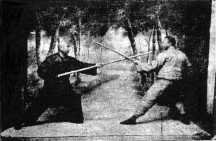The Taji Spear/Staff/Halbard
Yang Lu Chan, the founder of the Yang style of Taijiquan was famous for his use of the spear and his feats with it are legendary. Traditionally this form was kept very secret and only passed on to trusted students. Even in Yang Cheng Fu's time the two man sticky spear sequence was taught but the full form was reserved for advanced students. His book 'The Uses of Taijiquan' records the two man 'sticky spear' practice and has some notes for solo practice.
 The techniques of the Taiji spear can be applied to both the staff and the halbard. There is an interesting story to how the Taiji spear came to be transmitted as the Taiji staff. Yang Ban Hou, the son of Yang Lu Chan was always getting into fights and for fear that her son might kill some one in advertantly, his mother cut off the spear head of his spear so that he could only use it as long staff. Yang Ban Hou was also very skilled with the spear as was his brother Yang Feng Hou (he died early).
The techniques of the Taiji spear can be applied to both the staff and the halbard. There is an interesting story to how the Taiji spear came to be transmitted as the Taiji staff. Yang Ban Hou, the son of Yang Lu Chan was always getting into fights and for fear that her son might kill some one in advertantly, his mother cut off the spear head of his spear so that he could only use it as long staff. Yang Ban Hou was also very skilled with the spear as was his brother Yang Feng Hou (he died early).
The Li manual only records a short spear sequence and Chen Yen Ling's book only a short solo exercise with the staff. In a recent book recording the old Wu forms of Yang Yu Ting, only a short solo sequence is shown also. The spear form has only been described in detail in very recent history. The Yang Taiji spear consists of 41 postures. The spear forms of the other schools of Taijiquan have yet to be comprehensively recorded.
Other solo exercises or short forms are known, some of them very short indeed but still encompassing the major movements of the spear techniques. The spear techniques are also applicable to the long staff and the halbard which is a kind of spear with a crescent knife edge at one side.
The staff like all the Taiji arts consists mainly of 13 techniques, the are:
1) Open (Kai)
2) Close (He)
3) Burst (Beng)
4) Split (Pi)
5) Dot (Dian)
6) Bind (Za)
7) Poke (Bo)
8) Hold Up (Liao)
9) Coil (Chan)
10) Lead (Dai)
11) Slip (Hua)
12) Intercept (Jie)
13) Stab (Cuo)
The spear/staff used for this weapon is usually made of a kind of wood known as 'white wax wood' which is light in colour and springy in nature. Its length should be about 2-2.5 metres and should be rather stout and tapering at one end. Hard wood staffs can also be used.
All comments are most welcome.
- The copyright is retained by the author so please do not publish it.
Check with me first if you want to do anything public with it.
- Please distrbute the document complete.
- This document was written for the benefit of fellow enthusiasts,
please do not use it for commercial purposes or profit making purposes.
 Back To Peter's Taijiquan Resource Page
Back To Peter's Taijiquan Resource Page
 Email Peter Lim Tian Tek
Email Peter Lim Tian Tek
 The techniques of the Taiji spear can be applied to both the staff and the halbard. There is an interesting story to how the Taiji spear came to be transmitted as the Taiji staff. Yang Ban Hou, the son of Yang Lu Chan was always getting into fights and for fear that her son might kill some one in advertantly, his mother cut off the spear head of his spear so that he could only use it as long staff. Yang Ban Hou was also very skilled with the spear as was his brother Yang Feng Hou (he died early).
The techniques of the Taiji spear can be applied to both the staff and the halbard. There is an interesting story to how the Taiji spear came to be transmitted as the Taiji staff. Yang Ban Hou, the son of Yang Lu Chan was always getting into fights and for fear that her son might kill some one in advertantly, his mother cut off the spear head of his spear so that he could only use it as long staff. Yang Ban Hou was also very skilled with the spear as was his brother Yang Feng Hou (he died early).  Email Peter Lim Tian Tek
Email Peter Lim Tian Tek